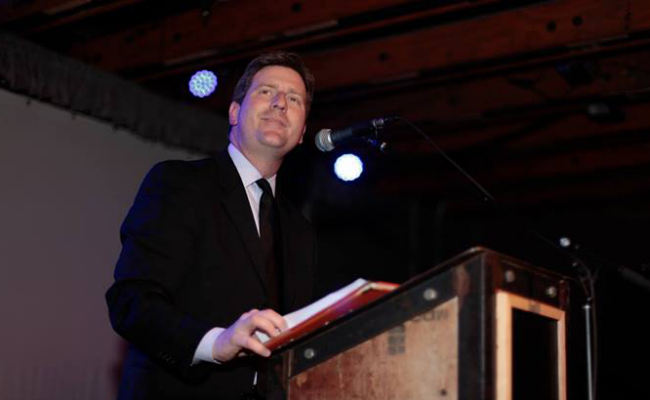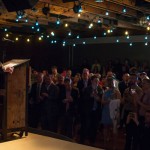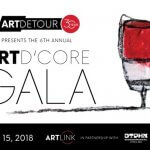On Saturday, March 1, Artlink Inc., in partnership with Downtown Phoenix Inc. hosted the Art d’Core Gala at Crescent Ballroom, which featured Mayor Greg Stanton giving his first “Celebrate Downtown” address. The event was sponsored by CityScape, APS, Phoenix Convention Center, Valley Metro, 12 News, City of Phoenix Aviation Department, Support Sky Harbor Coalition, United Phoenix Fire Fighters, and Gammage & Burnham Attorneys at Law.
Despite the spring rain, more than 500 Phoenicians attended the event that celebrated the contribution of the arts and local culture to the resurgence of downtown, adding color and vibrancy to our urban core. It served as a festive kick-off to Artlink’s Art Detour 26, March 8-9, 2014.
Below is the transcript of the Mayor’s address.
Celebrate Downtown Address
Saturday, March 1, 2014
Special thank you to Catrina Kahler, the Artlink Board Chair who organized this incredible event. I want to thank Downtown Phoenix, Inc. Let me tell you about what they did just recently. When our Legislature passed S.B. 1062, DPI spoke out, and joined an overwhelming majority in our community by writing Governor Brewer a letter asking her to veto that terrible legislation. DPI stood up for Phoenix’s anti-discrimination ordinance, because we all know that an inclusive community is a stronger community.
I’m so happy to be with you to Celebrate Downtown – because there is a lot to celebrate. Downtown is back! Downtown is certainly alive tonight.
“…the fabric of a vibrant community isn’t any set of buildings. It’s the people. It’s residents, artists, entrepreneurs, restaurateurs. It’s you.”
That’s such good news – and for many people around the city and Valley, that may be unexpected news.
That’s because for so many decades, downtown Phoenix really struggled. Once grand buildings at the heart of our city were left to deteriorate or were torn down. Busy streets fell silent as new development lured businesses and customers. Eventually, people moved away from downtown too.
Many in our community sought to change that.
In the 90s, new development brought people back – at least for events. But even great venues like America West Arena and Bank One Ballpark weren’t enough. I came to the City Council more than a decade ago, and at that time, we pushed for forward-thinking investments. Investments that made the Biomedical Campus, T-Gen and ASU Downtown possible.
In 2000, the entire city took a risk, voting for and uniting behind Light Rail. That made it easier for everyone to get to our downtown.
Finally, after so many years of hard work, we were making progress.
Then, the recession hit. Arizona took it hard. Downtown Phoenix too. Those investment dollars came to a screeching halt.
Those times were tough, but for all of the heartache, there was also a silver lining. . . It gave us
time. Time to pause and really think about the kind of downtown we wanted. Did we have the right people at the table?
Because as far as we had come – deep down, all of us knew we could do even better.
Yes, constructing those “signature buildings” was important. But we had to do more. We had to show that downtown can be a neighborhood too. A community with life. And the fabric of a vibrant community isn’t any set of buildings. It’s the people. It’s residents, artists, entrepreneurs, restaurateurs. It’s you.
And it also gave us time to understand that our downtown doesn’t have to look or feel the same as downtowns in other cities. The urban cores of other big cities were shaped a century ago, and are chained to the ideas of the past.
“…our city’s relative youth is one of our greatest strengths. That’s because the people in this community, the people in this room – we are in control of downtown’s destiny.”
We’re not. When downtowns across the country lost their residents to the suburbs after World War II, Phoenix was too young to have a big downtown. And too many of the buildings that were here were torn down.
We have to learn from those mistakes.
But like it or not, much of downtown Phoenix today is a fresh canvas.
Phoenix is a big city. But we’re still a young city. But our city’s relative youth is one of our greatest strengths. That’s because the people in this community, the people in this room – we are in control of downtown’s destiny.
The decisions we make – not me, we – will determine our future. This won’t be shaped by outside forces. As long as I’m your Mayor, it will be shaped by you.
We will realize our shared vision for downtown: a vibrant, walkable, livable community where education, the arts, and commerce thrive.
That’s the downtown that works for us. . . all of us.
Getting there means we have to break free from the old way of doing things.
Re-organize the decision-making process, and build one that fostered teamwork and creativity. Create a process that includes everyone.
When I ran for Mayor, I said I’d make that a priority so you would have more than a seat at the table. You’d have a voice in making decisions.
Downtown Phoenix, Inc.
This is what Downtown Phoenix, Inc. is for.
“…for the first time – the arts community, downtown residents, Downtown Phoenix Partnership, Phoenix Community Alliance, and businesses large and small are all working together on the same page.”
We looked at how other cities with growing and urban downtowns operated – and we took the best of their ideas.
In D-P-I, we have a new structure that coordinates downtown’s activities much more efficiently. But most important – D-P-I brings everyone together. We have great community representation on its board in Cindy Dach, Tim Eigo, and Kimber Lanning. And in Dave Kreitor, we have a leader who understands every part of downtown.
This new unity means that – for the first time – the arts community, downtown residents, Downtown Phoenix Partnership, Phoenix Community Alliance, and businesses large and small are all working together on the same page.
D-P-I gives us the tools we need to use every part of downtown to create new things, big and small.
Vibrant Downtown
And D-P-I is working with Roosevelt Row and many others who have already helped create a sheer number of events beyond what we could have ever imagined just a few years ago. Think about it:
• McDowell Mountain Music Festival
• Phoenix Festival of the Arts
• The first Viva Phoenix with more than 50 bands coming next weekend
Every week, something unique is happening to bring life to our downtown. And we are getting ready to showcase downtown Phoenix on an international stage by hosting the Super Bowl.
It will bring in hundreds of thousands of people to our downtown each night in the days leading up to the game. But it can only be successful if each of you is at the table and help as we plan those events.
That’s precisely what Downtown Phoenix, Inc. is all about.
It’s about the everyday energy we feel in our community.
We know how important that is because we all remember when too often this area felt more like a ghost town than a downtown.

DPI CEO David Krietor, Artlink Board Chair (and DPJ Publisher) Catrina Kahler and Mayor Greg Stanton
Urban, Walkable Downtown
I remember just a couple of years ago going to Lola’s coffee on a Sunday afternoon. There was hardly anyone around. A few weeks ago when I was there it hit me – it was full, and so was Pita Jungle next door. There were people walking and biking, relaxing, eating, walking dogs.
That’s the future we all hope for: urban, walkable, and multi-modal.
We’ve done a lot of things to move downtown in that direction.
In 2011, Phoenix passed a new Downtown Form Code that set new rules for development, and tried to direct the street experience.
That was a good first step. When I took office, though, I thought we could do more – especially for pedestrians.
We took action, making big changes that went into effect just last year.
And wow – for the first time – nearly every downtown street is a designated pedestrian street. Here’s why that’s important.
• New construction now must include ground-level activation, and provide shade for sidewalks. Every single property has to be walkable.
• Apartment buildings – they all have to include bike racks. High-rise office buildings –must have showers for those who want to bike to work.
• And though it has been a long time coming, our bike share program finally is nearing the end of testing and will be rolling out soon.
“That’s the future we all hope for: urban, walkable, and multi-modal.”
With the right projects, we can capitalize on that progress. The City of Phoenix has put out an R-F-P to make new and better use of property at Central and Van Buren so we can advance multi-use centers that bring in new residents.
We are working on a new Complete Streets Plan that represents an entirely new approach to how we design and build our streets. It recognizes the fundamental idea that every street should accommodate pedestrians, bikes, transit, and … yes, even cars too.
The plan may not be done yet, but we’re already getting to work. We’ve already started a few new road diets to make our community more walkable.
The Grand Avenue folks approached us with a good idea: use new paint to narrow Grand Avenue and allow plants, parks and other things in the right of way. Create more walkable space, let restaurants use the space for seating.
We got it done in about six months – record-breaking time that shows we’re serious. If you haven’t been to Grand Avenue, please, go check it out.
We did the same thing on First Street from Pierce all the way up to Hance Park. It’s temporary and not perfect, but it’s a huge improvement.
We’re re-thinking one-way streets, and exploring whether it would be better to have two-way streets in some places instead. Yes, one way streets serve a purpose; they make it easier to people to get in and out. But two-way streets are better for neighborhoods, and better for small business owners.
At the same time we’re transforming our streets, we’re turning dilapidated buildings into new businesses and homes.
Through our adaptive reuse program, the City is waiving its fees and making it easier for those who want to find new use for old buildings.
That’s been incredibly powerful in the Warehouse District – where we’re sending the message that, yes, you too are a part of downtown.
All along Grant Street south of Lincoln: WebPT, the Herberger Institute of Design, Michael Levine’s buildings. The Press Room on Madison.
In other parts of downtown, great place like the Public Market Café, Angel’s Trumpet, and Pomo were possible in part because of the adaptive reuse program. Two projects I’m most excited about are in the works: the renovations of Luhrs Tower and the Hotel Monroe. These historic structures have been under-used for years – but will soon add new life to downtown.
Hub for Education, Entrepreneurs and Commerce
As we preserve the buildings of our past, we’re also creating new centers for education, entrepreneurs and commerce.
We’re supporting new K-12 schools – good schools – in our urban areas because downtown must be a place for families with children too.
At same time, we’re becoming a hotspot for higher learning There were so few students in downtown just a decade ago. By 2020, there will be more than 17-thousand. That’s exciting.
Like any big experiment, there have been a few bumps in the road. But with each project, it gets better and better.
And now, the highest-ranked education opportunities in Arizona are – or soon will be – offered in downtown Phoenix.
• U of A’s medical school, which will open one of the top cancer centers in the country next year.
• ASU’s Sandra Day O’Connor College of Law – one of the top 10 public law schools in the nation – will move downtown in 2016.
• NAU’s nursing school, U of A’s pharmacy school, the Herberger School of Design.
And these aren’t the only places spurring new, innovative ideas.
Co-working spaces are booming. Co+Hoots is already at its limit and expanding.
“…we finally have engaged residents who have created a fantastic community.”
That makes a difference all over the Valley, and all over Arizona. The activity in a strong downtown can shape the economy of our entire region.
In north Phoenix, up near Desert Ridge, we’re building a massive, thousand-acre biomedical corridor.
It will also create new jobs – good jobs – but it never would have been possible without the success of the Downtown Biomedical Campus.
A strong downtown contributes everywhere because no other part of our region can claim such a unique and vibrant integration of residents, academics, art, government, commerce and entrepreneurs.
Downtown Phoenix is truly one of a kind.
The Future
Just two years ago, the conversation we were having was about how downtown was on the brink of turning the corner.
Today, it finally has.
And the conversation we continue to have is, “How we can best work together to make downtown even stronger?”
There’s a lot of work to do. As I said earlier, in many ways, we’re working with a fresh canvas. Yes, we’ve got a few old buildings we need to save. We have empty lots we need to change. But we finally have engaged residents who have created a fantastic community.
I can’t read the future, but I can tell you where I think downtown Phoenix is headed.
It will build on its role as the transit hub of the Valley. And one day Light Rail will integrate the areas south of downtown as part of the community, as well as the Capitol Mall and beyond.
We will be home to thousands more entrepreneurs and start ups.
The arts community will be firmly established.
New residents will be able to choose from a wide variety of housing options.
And those who want to ride their bike or walk to work or a restaurant – and one day, a grocery store – will find it easier than ever before.
I guarantee you it will not always be easy. There will be a lot of debate and even some mistakes along the way. That’s what makes downtown unique. Each of you is smart, creative and engaged. We’ll get it right, but only if you hold the City’s feet to the fire and demand excellence.
We’ve known each other and worked together for many years now. I’m incredibly proud of what you’ve done to shape our community. That’s why it means so much to me when you’ve called me “the downtown Mayor.”
I love downtown because it belongs to you. It belongs to everyone.
Let’s continue to make it as incredible as we know it can be.
Thank you.
Photos by Christopher Boats O’Shana. Courtesy of Artlink Inc.








